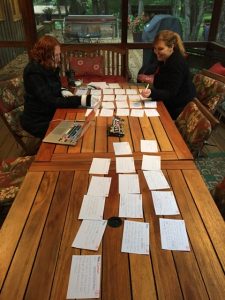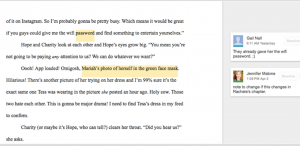Good morning! Who’s feeling brave this week? It’s Friday, which means it’s time to check in with Gae on her blog and get some feedback on your work-in-progress if you’d like.
We also have guest author Jen Malone joining us. Jen’s titles include AT YOUR SERVICE, YOU’RE INVITED, and THE SLEEPOVER. Her next project is a book written with friends, in multiple points of view. Jen’s joining us today to talk about how that all works!


Group Projects: They’re Not Just For Your Students
The very words “group project” can strike fear in the hearts of your students, but their teachers know better, right?
The writer’s room tends to be a mythical place, typically reserved for TV show scribes, but I’m here to make a case for exactly that type of banding-together approach across all types of fiction. And, in the true spirit of collaboration, I’ve invited some friends to join me (well, not just my friends, but my co-authors.)
The seven of us are about to turn in a manuscript for a multi-authored middle grade novel called Seven Sides to Every Story, which will publish with Simon & Schuster next summer and which we pitched as, “Following the format of the film Love Actually, seven students’ storylines intersect over the course of one night at a middle school dance.”
When I first approached these talented ladies with the idea for a book authored by seven people that would NOT be an anthology, but rather one continuous story, every last one of them said “sign me up” before I even got to the details. And then we set to work figuring out, um, how exactly do we do that?
We hope to persuade everyone to try this type of writing (really you should- it’s fun, we promise!) so here’s a little conversation about what it’s been like in the trenches:
Jen Malone (At Your Service, The Sleepover, co-author of You’re Invited series): Rachele, what were your first thoughts when I mentioned this idea?
Rachele Alpine (Operation Pucker Up, You Throw Like A Girl): My immediate reaction? Bring on the crazy! Seriously, I was thrilled to be a part of a project with some of my favorite middle grade authors. I wasn’t sure how (or if!) we’d be able to pull it off. Seven people working on one story sounded like a whole lot of different opinions, but I was up to the challenge from the get go!
Jen: So how exactly are we doing it? Alison? Gail?
Alison Cherry (The Classy Crooks Club, Willows vs. Wolverines): I couldn’t fathom how seven people could possibly agree on one plot and put together an outline that made sense—I can’t even agree with myself about the plots of my books half the time. But it didn’t turn out to be that much of a challenge at all! The seven of us had a long conference call and talked through who each of our characters would be. Then each of us submitted a short explanation of our character’s basic three-act structure, which Jen and I then chopped up and pieced together into a full-book outline. Shockingly enough, the draft we ended up with adhered almost exactly our original plan!
Jen: Ah yes! I have a picture of that notecard-shuffling in action, Alison. Here are the two of us taking over the porch on a writing retreat. Thus far, this has been the only part of the writing process that actually happened in person (and even then, only between two out of the seven of us)! Obviously, M&Ms were critical to the process.

Gail Nall (Breaking the Ice, Out of Tune, co-author of You’re Invited series): Truly adorable picture. I’ll summarize the process: 1) a really good outline, 2) flexibility (no big egos allowed!), 3) an awesome editor and 4) Google docs.
Jen: Yes, Google Docs has been a lifesaver. We can all work at once in the document and leave comments for each other as we go. Here’s an example:

Jen: Ronni, what’s been the most enjoyable aspect to writing like this?
Ronni Arno (Ruby Reinvented, Dear Poppy): Friends! I’m an extrovert, and writing is a fairly introverted activity. The fact that I get to connect with my friends/co-authors on this project makes it so much more fun. I love bouncing ideas off of each other, sharing thoughts, and reading what everyone else has written. The fact that we have to incorporate our characters into other characters’ chapters (and vice versa) has been a new experience, too, and I think it intensifies the creative process.
Jen: Definitely social, which is not often a word associated with writing a book. We have a private Facebook page where we can brainstorm solutions together, pop questions up for debate, or even (this happened just this week) answer a poll to vote for a character’s new name. Here’s a screenshot from our initial Google Hangout brainstorming call. (hmm… perhaps we need to be thanking Google in the acknowledgments of this book). Don’t we make it look fun?

Jen: Laughs aside, there has been a learning curve to writing a book in such an unusual way. Alison, what’s been the most challenging for you?
Alison: This isn’t the first collaborative book I’ve written, but the other project involved only two other people, both of whom have been my first-line-of-defense critique partners and close friends for years. Since we’ve read so, so (so so so so) many drafts of each other’s writing, we understand one another’s processes, and giving criticism in a way that makes sense to us has become pretty second-nature. Since I know some of my Seven Sides coauthors significantly less well, we don’t have that kind of shorthand, and that sometimes made it challenging to communicate what I meant in a way everyone could understand. It’s a lot easier to say, “Dude, this chapter makes no sense” to someone you’ve contacted thirty other times that day than it is with someone you’ve never spoken to one-on-one! In general, though, I think we’ve handled this admirably, and it’s been really good practice in explaining my thoughts clearly.
Jen: I would say the same for me, with regard to gaining experience explaining thoughts clearly and tactfully—and that’s never a bad skill for any of us to hone, since we need to be able to do that with critique partners, agents, and/or editors, even when writing on our own. Speaking of our own projects… Dee, how have you juggled working on this book alongside your other solo manuscripts?
Dee Romito (BFF Bucket List, Arrivals and Departures) This book came along at an interesting time because I not only had a deadline for another book, but I was also preparing for my debut middle grade to release. Fortunately, there was such a strong outline for Seven Sides, and structured dates for when chapters were to be turned in or critiqued by, that it was easy to see which project I needed to work on at any given time. Plus, it was so fun working with this group that I usually couldn’t wait to dive back in.
Ronni: I’ll add that it was so great to get on the phone with Dee to hash out our characters’ scenes—knowing that someone else was counting on me helped keep me on task!
Jen: Stephanie, what makes a collaboration like this different from your solo pieces of writing?
Stephanie Faris (30 Days of No Gossip, 25 Roses, Piper Morgan series): Collaborating means letting go of that personal attachment you have to a story a little because what you’re writing feeds into the “greater good” of the work you’re doing. It’s like being an actor in a movie–while you’re over here connecting with your character’s journey, six other authors are connecting with their characters and you’re all working to make the end product as a whole great. So when someone suggests something as an overall change, your job is to go in and make sure that change not only makes your scene work better, but makes their scene work better, as well.
Jen: Well said! I’ll also mention that being open to new formats and styles of writing has taught me a lot I can and will apply to my own solo projects. I never used to plot heavily, but seeing how much more quickly I could draft with an outline in place (a total necessity for a project of this scope) converted me for life.
As teachers, you have a set of skills and strengths developed in the classroom that can lend itself well to this type of project. Engaged educators are always crowd-sourcing ideas and may be accustomed to fitting outside-the-box creative approaches into a mandated curriculum and/or managing others to achieve a common goal.
So here’s a challenge for you: Create a group project of your own by looping one, two, or a dozen Teacher’s Write participants in on the next writing prompt you try. Feel free to use the comment box below to find others eager to team up. M&Ms are optional.





Dear Jen, thanks for sharing. It’s true that group work can be a challenge but I love this idea especially with my young students. We ask them to write individually which is scary at that age. A group idea would be great. Thanks and can’t wait to read the book. Thanks also to all the rest of you.
I love this post! Last year was our first year using Google Docs in my district and we are thrilled to explore it more next year. Great suggestion to create a collaborative writing project with TW participants!
Such a fun idea!
This sounds like you’re all having such a great experience with this book! What a great idea! Some of my fondest memories of childhood friendships were with fellow writers when we’d collaborate on multiple point of view stories. Of course, this was before the internet and the glories of Google Docs. 🙂
Thanks for sharing your experience. I look forward to reading the book!
Hi, Jen and TW campers!
What a cool idea! If any other campers would like to do a little writing prompt activity together, I am up for the challenge. How fun!
Thanks for the post. I have an activity that I do with my sixth grade writers that are struggling. We sit down together in the prewriting stage and discuss the topic/theme of our story. Once we decide on the topic/theme, we discuss the plot and how we imagine that it will progress. Then, it is time to write. I write the first paragraph, and after it is completed, I pass it along to the student for him/her to write the next paragraph. The shortest story that I have written with a struggling writer is ten paragraphs and the longest was twenty-two paragraphs (we chunk dialogue into what we consider to be a paragraph – example: a four to six line discussion between characters is one paragraph). This writing activity has helped many students find their confidence with their own writing. It has also helped build the trust between the writing teacher (that would be me), and the student, which is the writer.
If anyone wants in on a collaborative writing task, please let me know. I will check back at the end of the weekend.:)
Thanks for the comments, everyone!!! Definitely a great thing to try in the classroom- perfect for the extroverts! Happy writing:)